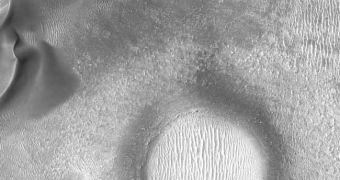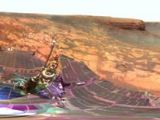So, why did Big Foot run on Mars? To get more publicity, why do you think? It's now official, what seemed to be an alien figure standing in the middle of the Martian desert is in fact only a rock sculptured by winds. However, NASA's Mars Reconnaissance Orbiter brings evidence which seems to contest the fact that the Red Planet's atmosphere would have been capable of shaping the terrain into the geological structures we see today.
While most bedforms on Mars take the shapes of small linear ripples across the surface, scientists have proof that they can also form on top of larger sand dunes. On Earth, the powerful action of the wind moves and forms small bedforms on a daily basis. The new observations conducted with MRO shows that sediments are deposited with the help of winds mostly on the downwind side of the rocks, and indicate the general directions of most of the winds that blow on the surface of the Red Planet, and can usually be observed with the help of the two Martian rovers, Opportunity and Spirit.
Recently, MRO's camera HiRISE has been able to spot features of the surface of the planet as small as half of a meter high, from distances of over 313 kilometer above. By using these images, scientists can point (as in the case of the small bedforms) the rough directions of the winds all over the surface of Mars.
Such structures are mostly referred to as 'yardangs' and had previously been observed by past orbiters, but scientists were unable to accurately reveal their texture, due to the low resolutions of the used cameras. On the other hand, HiRISE can take much better pictures, and can show how these yardands are formed of multiple layers of rock that have been eroded over time by the wind.
Considering the fact that winds are rather mild on the surface of Mars, scientists argue that part of these layers of rocks are composed of relatively soft materials which are, most likely, volcanic ash that has been incorporated into rocks during the mixing process with water ice, dry ice and dust.
Part of the planetary scientists all over the world have already started researching Mars' geology, by using images provided by MRO's HiRISE camera to compare them with the pictures taken with previous Mars orbiters or even by the Mars Exploration Rovers, and found that some areas around Victoria Crater presented features similar to those of the yardangs.
Alfred McEwen, from the University of Arizona Lunar and Planetary Laboratory, said that part of the yardangs found around Victoria Crater presented rather surprising characteristics, while others were just considered uninteresting. Nevertheless, he was surprized of the diversity of morphology of the thick dust mantles. Against general belief that pictures the surface of Mars as a smooth blanket of dust, the wind and the cementation phenomenon carves rock into complex patterns.

 14 DAY TRIAL //
14 DAY TRIAL // 
